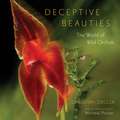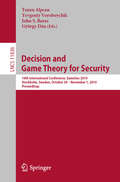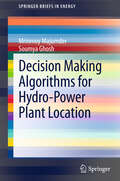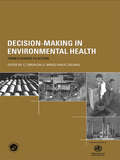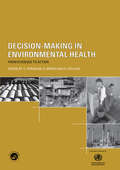- Table View
- List View
Deception in the Digital Age: Exploiting and Defending Human Targets through Computer-Mediated Communications
by Thomas Holt Cameron H. Malin Terry Gudaitis Max KilgerDeception in the Digital Age: Exploiting and Defending Human Targets Through Computer-Mediated Communication guides readers through the fascinating history and principles of deception—and how these techniques and stratagems are now being effectively used by cyber attackers. Users will find an in-depth guide that provides valuable insights into the cognitive, sensory and narrative bases of misdirection, used to shape the targeted audience’s perceptions and beliefs. The text provides a detailed analysis of the psychological, sensory, sociological, and technical precepts that reveal predictors of attacks—and conversely postmortem insight about attackers—presenting a unique resource that empowers readers to observe, understand and protect against cyber deception tactics. Written by information security experts with real-world investigative experience, the text is the most instructional book available on the subject, providing practical guidance to readers with rich literature references, diagrams and examples that enhance the learning process. Deeply examines the psychology of deception through the lens of misdirection and other techniques used by master magicians Explores cognitive vulnerabilities that cyber attackers use to exploit human targets Dissects the underpinnings and elements of deception narratives Examines group dynamics and deception factors in cyber attacker underground markets Provides deep coverage on how cyber attackers leverage psychological influence techniques in the trajectory of deception strategies Explores the deception strategies used in today’s threat landscape—phishing, watering hole, scareware and ransomware attacks Gives unprecedented insight into deceptive Internet video communications Delves into the history and deception pathways of nation-state and cyber terrorism attackers Provides unique insight into honeypot technologies and strategies Explores the future of cyber deception
Deceptive Beauties: The World of Wild Orchids
by Christian ZieglerConfucius called them the “king of fragrant plants,” and John Ruskin condemned them as “prurient apparitions.” Across the centuries, orchids have captivated us with their elaborate exoticism, their powerful perfumes, and their sublime seductiveness. But the disquieting beauty of orchids is an unplanned marvel of evolution, and the story of orchids is as captivating as any novel. As acclaimed writer Michael Pollan and National Geographic photographer Christian Ziegler spin tales of orchid conquest in Deceptive Beauties: The World of Wild Orchids, we learn how these flowers can survive and thrive in the harshest of environments, from tropical cloud forests to the Arctic, from semi-deserts to rocky mountainsides; how their shapes, colors, and scents are, as Darwin put it, “beautiful contrivances” meant to dupe pollinating male insects in the strangest ways. What other flowers, after all, can mimic the pheromones and even appearance of female insects, so much so that some male bees prefer sex with the orchids over sex with their own kind? And insects aren’t the only ones to fall for the orchids’ charms. Since the “orchidelirium” of the Victorian era, humans have braved the wilds to search them out and devoted copious amounts of time and money propagating and hybridizing, nurturing and simply gazing at them. This astonishing book features over 150 unprecedented color photographs taken by Christian Ziegler himself as he trekked through wilderness on five continents to capture the diversity and magnificence of orchids in their natural habitats. His intimate and astonishing images allow us to appreciate up close nature’s most intoxicating and deceptive beauties.
Deceptive Beauties: The World of Wild Orchids
by Christian ZieglerConfucius called them the “king of fragrant plants,” and John Ruskin condemned them as “prurient apparitions.” Across the centuries, orchids have captivated us with their elaborate exoticism, their powerful perfumes, and their sublime seductiveness. But the disquieting beauty of orchids is an unplanned marvel of evolution, and the story of orchids is as captivating as any novel. As acclaimed writer Michael Pollan and National Geographic photographer Christian Ziegler spin tales of orchid conquest in Deceptive Beauties: The World of Wild Orchids, we learn how these flowers can survive and thrive in the harshest of environments, from tropical cloud forests to the Arctic, from semi-deserts to rocky mountainsides; how their shapes, colors, and scents are, as Darwin put it, “beautiful contrivances” meant to dupe pollinating male insects in the strangest ways. What other flowers, after all, can mimic the pheromones and even appearance of female insects, so much so that some male bees prefer sex with the orchids over sex with their own kind? And insects aren’t the only ones to fall for the orchids’ charms. Since the “orchidelirium” of the Victorian era, humans have braved the wilds to search them out and devoted copious amounts of time and money propagating and hybridizing, nurturing and simply gazing at them. This astonishing book features over 150 unprecedented color photographs taken by Christian Ziegler himself as he trekked through wilderness on five continents to capture the diversity and magnificence of orchids in their natural habitats. His intimate and astonishing images allow us to appreciate up close nature’s most intoxicating and deceptive beauties.
Deciphering Chemical Language of Plant Communication (Signaling and Communication in Plants)
by James D. Blande Robert GlinwoodThis book provides an overview of the intricacies of plant communication via volatile chemicals. Plants produce an extraordinarily vast array of chemicals, which provide community members with detailed information about the producer’s identity, physiology and phenology. Volatile organic chemicals, either as individual compounds or complex chemical blends, are a communication medium operating between plants and any organism able to detect the compounds and respond. The ecological and evolutionary origins of particular interactions between plants and the greater community have been, and will continue to be, strenuously debated. However, it is clear that chemicals, and particularly volatile chemicals, constitute a medium akin to a linguistic tool. As well as possessing a rich chemical vocabulary, plants are known to detect and respond to chemical cues. These cues can originate from neighbouring plants, or other associated community members. This book begins with chapters on the complexity of chemical messages, provides a broad perspective on a range of ecological interactions mediated by volatile chemicals, and extends to cutting edge developments on the detection of chemicals by plants.
Deciphering Drug Targets for Alzheimer’s Disease
by Dileep Kumar Vaishali M. Patil Dee Wu Nanasaheb ThoratThis book explains the fundamental characteristics and biofunctionality of Alzheimer’s Disease drug targets and provides up-to-date information on the full range of their biomedical applications. An introductory section gives an overview of the recent developments related to drug targets identified and studied related to Alzheimer’s Disease and key developments from preclinical and clinical studies focusing on various molecular targets related to AD and dementia by subject experts all around the globe. Here, individual chapters address the progress and perspectives in human and non-human research, role of various biomarkers as an overview, advanced gene therapy, and novel compounds for therapeutic targets for Alzheimer’s disease. The book will be essential reading for graduate students, scientists, and engineers in any of the biomedical research fields in which efforts are being made to utilize novel drug targets and develop effective strategies for new drug targeting and delivery in Alzheimer’s disease treatment.
Deciphering Science and Technology: The Social Relations of Expertise (Explorations in Sociology.)
by Maureen McNeil Ian Varcoe Steven YearleyAs science and technology have pervaded modern life to an ever greater degree, social scientists have been led to find questions of the causes and consequences of 'expert' knowledge arising in places that would have been felt unlikely hitherto. Varcoe, McNeil and Yearley's book assembles nine exemplary studies by sociologists, each of which explores an aspect of the current scientific-technological 'revolution'. Some popular ideas are challenged. So, too, implicitly, are certain large-scale social scientific theories claiming to have discerned in science and technology an overall meaning.
Deciphering the Universe through Spectroscopy (Reviews in Modern Astronomy #22)
by Regina Von BerlepschThis 22nd volume in the series contains 15 invited reviews and highlight contributions from outstanding speakers presented during the 2009 annual meeting of the Astronomical Society on the subject of "Deciphering the Universe through Spectroscopy", held in Potsdam, Germany. Topics range from the measurements of magnetic fields on the surface of the sun via detailed measurements of abundances in stellar atmospheres to the kinematics of the universe at its largest scales. The result is a systematic overview of the latest astronomical and cosmological research.
Deciphering the Universe through Spectroscopy: Deciphering The Universe Through Spectroscopy (Reviews in Modern Astronomy #22)
by Regina Von BerlepschThis 22nd volume in the series contains 15 invited reviews and highlight contributions from outstanding speakers presented during the 2009 annual meeting of the Astronomical Society on the subject of "Deciphering the Universe through Spectroscopy", held in Potsdam, Germany. Topics range from the measurements of magnetic fields on the surface of the sun via detailed measurements of abundances in stellar atmospheres to the kinematics of the universe at its largest scales. The result is a systematic overview of the latest astronomical and cosmological research.
Decision Analysis Applied to the Field of Environmental Health (Professional Practice in Earth Sciences)
by Dilber Uzun Ozsahin Berna Uzun Tamer Sanlidag James LaMoreauxThis book provides students and researchers with a resource that includes the current application of the multi-criteria decision theory in a variety of fields, including the environment, health care, engineering, and architecture. There are many critical parameters (criteria) that can directly or indirectly affect the consequences of various decisions. The application of the multi-criteria decision theory focusses mainly on the use of computational methods which include multiple criteria and orders of preference for the evaluation and the selection of the best option among many alternatives based on the desired outcome. The theory of multi-criteria decision making (MCDM) is an approach that can be extremely useful for students, managers, engineers of manufacturing companies, etc.
Decision and Game Theory for Security: 10th International Conference, GameSec 2019, Stockholm, Sweden, October 30 – November 1, 2019, Proceedings (Lecture Notes in Computer Science #11836)
by Tansu Alpcan Yevgeniy Vorobeychik John S. Baras György DánThis book constitutes the refereed proceedings of the 10th International Conference on Decision and Game Theory for Security, GameSec 2019,held in Stockholm, Sweden, in October 2019.The 21 full papers presented together with 11 short papers were carefully reviewed and selected from 47 submissions.The papers focus on protection of heterogeneous, large-scale and dynamic cyber-physical systems as well as managing security risks faced by critical infrastructures through rigorous and practically-relevant analytical methods.
A Decision-centred View of Environmental Planning (Urban and Regional Planning Series #Volume 38)
by A. FaludiPlanning theorists are often criticised for being insufficiently concerned with the needs of practitioners. The author of this book takes a view of planning which centres around the decision-making process and offers a theoretical approach which takes practice as its starting point. Building on his earlier important work, Planning Theory (Pergamon URPS 1984, first edition, 1973), this book constitutes a further major advance in planning thought, synthesizing the influence of the British IOR School with the American 'rational planning model'. Going beyond previous 'generic' approaches, the work culminates in a consideration of theory and practice in the planning of all forms of environmental intervention.
Decision Making: Towards an Evolutionary Theory of Human Action
by Mauro MaldonatoSince the dawn of time human beings have had to make decisions. Wise or foolish, thoughtful or instinctive, altruistic or selfish, decision-making -- from the most simple to the most complex -- enables people to confront and overcome constant environmental challenges. Yet, despite the momentousness of decision-making in adaptability terms, men and women ignore the actual process that takes place in their minds when, for example, they invest in the stock market, buy a car, trust a person they just met, or simply decide to go to the movies. While some decisions are taken in a few seconds (when we act impulsively without time to evaluate the process), other decisions require considerable cognitive effort and accurate cost-benefit analysis. But is it only the optimal decision that deserves to be called rational? If this is the case, how then can we explain the wisdom of our instincts, of our emotions, of our 'sixth sense'? Moreover, what is the role of subjectivity, free will, desire, culture in the decision-making process? Research on decision-making has had a long and controversial history. The idea of a perfect rationality has more recently given way to the idea of a rationality conscious of its incompleteness -- to a process that cannot be expressed or conceived in logical or rational terms. In this ground-breaking book, Mauro Maldonato reinterprets the secular controversy about the nature of human decision-making in light of recent discoveries in cognitive neurosciences and new research (neuroeconomics and neuroethics). At the end of this literary excursion along a stunning archipelago of rationality, morality, emotion and consciousness, the reader is provided with the means to view and assess personal decision-making and resultant action in a completely different way -- a way that impacts positively on human interaction and psychological wholeness.
Decision Making Algorithms for Hydro-Power Plant Location (SpringerBriefs in Energy)
by Mrinmoy Majumder Soumya GhoshThe present study has attempted to apply the advantage of neuro-genetic algorithms for optimal decision making in maximum utilization of natural resources. Hydro-power is one of the inexpensive, but a reliable source of alternative energy which is foreseen as the possible answer to the present crisis in the energy sector. However, the major problem related to hydro-energy is its dependency on location. An ideal location can produce maximum energy with minimum loss. Besides, such power-plant also requires substantial amount of land which is a precious resource nowadays due to the rapid and uncontrolled urbanization observed in most of the urban centres in the World. The feasibility of such plants also depends on social acceptance as well as the level of environmental casualty and economic benefit, all of which is also spatially dependent. Decision making algorithms are applied to identify better solution if a problem has more than one alternative explication. Nature based algorithms are found to be efficient enough to catalyze such kind of decision making analysis. That is why the present study tries to utilize nature based algorithms to solve the problems of location selection for hydropower plants. The study employed six different types of nature based algorithms to select one of the locations among many available for installation of hydropower plant in the North Eastern part of the Indian subcontinent. The locations are selected based on their in stream resources and included in the decision making as alternatives. A methodology of criteria selection, determination of weightage and applications of bioinspired algorithms are adopted to produce utmost exertion of the available natural resources with minimum hostility and wastage of the same.
Decision Making and Modelling in Cognitive Science
by Sisir RoyThis book discusses the paradigm of quantum ontology as an appropriate model for measuring cognitive processes. It clearly shows the inadequacy of the application of classical probability theory in modelling the human cognitive domain. The chapters investigate the context dependence and neuronal basis of cognition in a coherent manner. According to this framework, epistemological issues related to decision making and state of mind are seen to be similar to issues related to equanimity and neutral mind, as discussed in Buddhist perspective. The author states that quantum ontology as a modelling tool will help scientists create new methodologies of modelling in other streams of science as well.
Decision Making for Complex Socio-Technical Systems: Robustness from Lessons Learned in Long-Term Radioactive Waste Governance (Environment & Policy #42)
by Thomas FlüelerThe long-term governance of radioactive waste continues to be a major complex and unresolved socio-technical issue. Previous technocratic approaches have so far failed. This empirically based study provides a novel approach to complementing technical expertise and economic/political power with stakeholder involvement. Inclusive participation is shown to be an asset that strengthens the processes, enhances robustness and facilitates sustainable decision making, thus adding value for all involved.
Decision-Making for Schools and Colleges
by Dean F. JuniperDecision-Making for Schools and Colleges contains activities and exercises designed to present decision-making principles to pupils and college students and guide them in their life choices. This book is divided into 16 units that cover the principles, limitations, and objectives of various decision-making programs. The opening units of this book provide the participants of the decision-making program the means to discriminate between important and unimportant decisions and a glimpse of decision-making in a wider than vocational frame. These topics are followed by the interrelationship between the aims, interests, and value of the program. The subsequent units present certain aspects of information and decision theories and their applications to the construction of Expectancy Tables. These units also provide simulated experiences that may, or may not, be directly applicable to participants’ eventual job choices. This book also deals with the value of consistent yardsticks for testing information of the written kind and checklist instruments of this kind in vocational and personal decision-making. Other units present the methods of judging a range of alternative courses of action based on their relation to the values and interests of the person who has to take a decision between them. Another unit focuses on various stages of contingency planning, together with their interconnections and the limits of the strategy. Some important and negligible consequences of decisions are tackled based on experiments, personal histories, and structured discussions. The concluding units deal with the structure of a considered decision in terms of the aim, information, and decision.
Decision-Making in Energy Systems
by Vivek D. BhiseThis is a comprehensive book on how to make complex decisions on energy systems problems involving different technologies, environmental effects, costs, benefits, risks, and safety issues. Using Industrial and Systems Engineering techniques for decision-making in Energy Systems, the book provides the background knowledge and methods to incorporate multiple criteria involved in solving energy system problems. It offers methods, examples, and case studies illustrating applications. Decision-Making in Energy Systems discusses subjective as well as objective methods, approaches, and techniques taken from the systems and industrial engineering domain and puts them to use in solving energy systems problems. It uses an integrated approach by including effects of all technical, economic, environmental, and safety considerations as well as costs and risks. The book is specially designed for practicing engineers from industrial/systems engineering who work in energy systems engineering industries. Aimed at graduate students, researchers, and managers involved in various energy generating, distributing, and consuming companies, the book helps the reader to understand, evaluate, and decide on solutions to their energy-related problems.
Decision-Making in Energy Systems
by Vivek D. BhiseThis is a comprehensive book on how to make complex decisions on energy systems problems involving different technologies, environmental effects, costs, benefits, risks, and safety issues. Using Industrial and Systems Engineering techniques for decision-making in Energy Systems, the book provides the background knowledge and methods to incorporate multiple criteria involved in solving energy system problems. It offers methods, examples, and case studies illustrating applications. Decision-Making in Energy Systems discusses subjective as well as objective methods, approaches, and techniques taken from the systems and industrial engineering domain and puts them to use in solving energy systems problems. It uses an integrated approach by including effects of all technical, economic, environmental, and safety considerations as well as costs and risks. The book is specially designed for practicing engineers from industrial/systems engineering who work in energy systems engineering industries. Aimed at graduate students, researchers, and managers involved in various energy generating, distributing, and consuming companies, the book helps the reader to understand, evaluate, and decide on solutions to their energy-related problems.
Decision-Making in Environmental Health: From Evidence to Action
by D. Briggs C. Corvalan G. ZielhuisDecision-Making in Environmental Health examines the need for information in support of decision-making in environmental health. It discusses indicators of environmental health, methods of data collection and the assessment of exposure to and the health impact of different environmental risk factors.
Decision-Making in Environmental Health: From Evidence to Action
by D. Briggs C. Corvalan G. ZielhuisDecision-Making in Environmental Health examines the need for information in support of decision-making in environmental health. It discusses indicators of environmental health, methods of data collection and the assessment of exposure to and the health impact of different environmental risk factors.
Decision Making in National Science Policy (Novartis Foundation Symposia #981)
by Maurice Goldsmith Julie Knight A. V. S. De ReuckThe Novartis Foundation Series is a popular collection of the proceedings from Novartis Foundation Symposia, in which groups of leading scientists from a range of topics across biology, chemistry and medicine assembled to present papers and discuss results. The Novartis Foundation, originally known as the Ciba Foundation, is well known to scientists and clinicians around the world.
Decision Making in Natural Resource Management: A Structured, Adaptive Approach
by Michael J. Conroy James T. PetersonThis book is intended for use by natural resource managers and scientists, and students in the fields of natural resource management, ecology, and conservation biology, who are confronted with complex and difficult decision making problems. The book takes readers through the process of developing a structured approach to decision making, by firstly deconstructing decisions into component parts, which are each fully analyzed and then reassembled to form a working decision model. The book integrates common-sense ideas about problem definitions, such as the need for decisions to be driven by explicit objectives, with sophisticated approaches for modeling decision influence and incorporating feedback from monitoring programs into decision making via adaptive management. Numerous worked examples are provided for illustration, along with detailed case studies illustrating the authors’ experience in applying structured approaches. There is also a series of detailed technical appendices. An accompanying website provides computer code and data used in the worked examples. Additional resources for this book can be found at: www.wiley.com/go/conroy/naturalresourcemanagement.

